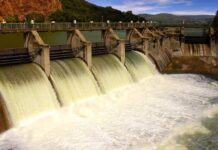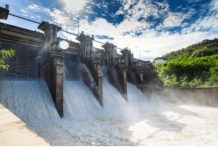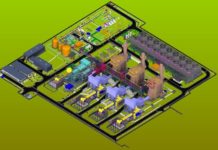The AES Paranรก power plant was the country’s first project-financed merchant power plant, an independent producer that sells electricity to the national grid without traditional long-term power purchase agreements.
The power station has two large industrial Mitsubishi Model 701F combustion turbine-generators (CTGs), two heat recovery steam generators (HRSGs) and a steam turbine. The main contract for the power plant was awarded to Mitsubishi Heavy Industries (MHI). MHI also maintains the plant.
AES PARANA POWER PLANT MAKE-UP
Two large industrial Mitsubishi Model 701F combustion turbine generators (CTGs) burn about 3.4 million mยณ/d of natural gas and generate approximately 526MW of electricity. As the Japanese Export Bank provided much of the finance, this may have affected the decision to award the contract to a Japanese company. The units operate at higher firing temperatures than earlier models (about 1,400ยฐC), increasing the efficiency with which they can convert thermal energy into electricity.
Hot exhaust gases from combustion turbines pass to two vertical heat recovery steam generators (HRSGs) where additional thermal energy is captured to generate steam. To increase the amount of steam generated, each HRSG inlet duct is equipped with a duct burner which fires an additional 0.2 million mยณ/d of natural gas. HRSG exhaust gases then pass to the atmosphere through stacks mounted on top of each HRSG, with an effective stack height of 65m.
A single steam turbine generator (STG) receives high-pressure steam from the HRSGs and generates up to an additional 319MW. Steam is then exhausted to a surface condenser that is cooled by water. The water is pumped from and to the Paranรก River. Condensate (water from the condensed steam) is recycled to the process. Cooling water is supplied by two 1,200kW circulating water pumps located in the existing CTSN pumphouse.
CCGT POWER PLANT BUILDINGS
The STG and associated equipment are contained in a steam turbine building adjacent to the river. This is the only major building in the power plant; the CTGs and HRSGs are outdoor installations. The CTGs are enclosed in weatherproof and acoustically treated enclosures. Plant auxiliary equipment uses approximately 19MW, leaving net plant output of 830MW at design conditions. The output of a combustion turbine-based plant varies somewhat with ambient air temperature.
Most utilities are provided to the power plant by the host CTSN facility under a services agreement. This includes demineralised make-up water, potable water, cooling water, wastewater treatment and back-up electrical power.
NATURAL GAS SUPPLY AND SUPPLY INTERRUPTION
The project uses natural gas for all of its daily requirements, with the potential for supply interruption of up to 30d/yr. The CTGs can burn No. 2 oil (distillate oil) in the event of natural gas supply interruption. No. 2 oil is stored in two existing 7,500mยณ tanks located in the CTSN fuel storage area. Each CTG can burn up to 1,800mยณ of oil per day. The storage tanks are replenished by barge or truck delivery as needed. Alternatively, the plant may be shut down during gas supply interruption, depending on the cost of No. 2 oil at that time.
ELECTRICITY TRANSMISSION AND GAS PIPELINE
The project also included the construction of 9km of electric interconnection to the national grid and 16km of natural gas distribution pipeline. Electricity produced in the generators of the two CTGs and the STG is conducted at 15kV to the two main transformers located behind the steam turbine building. These transformers boost voltage to 500kV for transmission to the grid along the interconnection.
FINANCE FOR THE POWER PLANT
The Inter-American Development Bank and the Japanese Export Bank (JEXIM) were both involved in financing the plant.












































